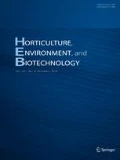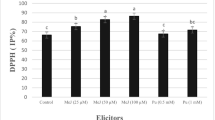Abstract
This study investigated jasmonic acid (JA) elicitation of the callus of two roselle accessions: HS003 (orange-red calyx) and HS005 (dark-red calyx). The goal was to identify the optimal exposure period for production of total anthocyanin, phenolics, and flavonoids and for enhancing DPPH radical scavenging. Dark-red callus was cultured on Murashige and Skoog (MS) medium supplemented with 4.52 µM 2,4-dichlorophenoxyacetic acid (2,4-D), 4.44 µM 6-benzyladenine, combined with 0 and 50 µM JA for treatment of HS003, and with 0 and 100 µM JA for treatment of HS005. Elicitation periods of 7, 14, 21, and 28 days were compared. Significant increases in both accumulation of bioactive compounds and enhancement of antioxidant activity were observed. In the case of HS003, the optimal exposure periods were 21 days for enhancement of total anthocyanin accumulation (1.48 ± 0.07 mg cyd-3-glu L−1, or 3.70 times that of the control) and 14 days for enhancement of total phenolic and flavonoid contents (114.72 ± 6.63 mg GAE g−1 dry extract and 106.15 ± 9.06 mg CE g−1 dry extract, or 6.89 and 18.59 times that of the control). In the case of HS005, elicitation with 100 µM JA for 28 days yielded the greatest increase in total anthocyanin (0.86 ± 0.06 mg cyd-3-glu L−1, or 6.61 times that of the control), phenolics (48.01 ± 2.47 mg GAE g−1 dry extract, or 3.37 times that of the control), and flavonoids (21.41 ± 1.89 mg CE g−1 dry extract, or 3.30 times that of the control). At all periods, and for both accessions, JA elicitation increased DPPH radical scavenging, compared with the control. Our results demonstrated that the dark-red callus of roselle accumulated greater amounts of bioactive compounds and exhibited enhanced antioxidant activity, following elicitation with JA for 14–21 days in the case of HS003 and 28 days in the case of HS005.





Similar content being viewed by others
Data availability
The datasets generated during and/or analysed during the study are available from the corresponding author on reasonable request.
References
Abbasi Bh, Tian CL, Murch SJ, Saxena PK, Liu CZ (2007) Light-enhanced caffeic acid derivatives biosynthesis in hairy root cultures of Echinacea purpurea. Plant Cell Rep 26:1367–1372
Abeda HZ, Kouassi MK, Yapo KD, Koffi E, Sie RS, Kone M, Kouakou HT (2014) Production and enhancement of anthocyanin in callus line of roselle (Hibiscus sabdariffa L.). Int J Rec Biotech 2:45–56
Ali BH, Wabel NA, Blunden G (2005) Phytochemical, pharmacological and toxicological aspects of Hibiscus sabdariffa L.: a review. Phytother Res 19:369–375
Ali M, Abbasi BH, Ali GS (2014) Elicitation of antioxidant secondary metabolites with jasmonates and gibberellic acid in cell suspension cultures of Artemisia absinthium L. Plant Cell Tiss Organ Cult 120:1099–1106
Blando F, Scardino AP, De Bellis L, Nicoletti I, Giovinazzo G (2005) Characterization of in vitro anthocyanin-producing sour cherry (Prunus cerasus L.) callus cultures. Food Res Int 38:937–942
Broeckling CD, Huhman DV, Farag MA, Smith JT, May GD, Mendes P, Dixon RA, Sumner LW (2005) Metabolic profiling of Medicago truncatula cell cultures reveals the effects of biotic and abiotic elicitors on metabolism. J Exp Bot 56:410
Chen H, Chen F (2000) Effects of yeast elicitor on the growth and secondary metabolism of a high-transhinone-producing line of the Ti transformed Salvia miltiorrhiza cells in suspension culture. Process Biochem 35:837–840
Chong TM, Abdullah MA, Fadzillah NM, Lai OM, Lajis NH (2005a) Jasmonic acid elicitation of anthraquinones with some associated enzymic and non-enzymic antioxidant responses in Morinda elliptica. Enzyme Microb Technol 36:469–477
Chong TM, Abdullah MA, Lai OM, Nor’Aini FM, Lajis NH, (2005b) Effective elicitation factors in Morinda elliptica cell suspension culture. Process Biochem 40:3397–3405
Da-Costa-Rocha I, Bonnlaender B, Sievers H, Pischel I, Heinrich M (2014) Hibiscus sabdariffa L.: a phytochemical and pharmacological review. Food Chem 165:424–443
Danaee M, Farzinebrahimi R, Kadir MA, Sinniah UR, Mohamad R, Taha RM (2015) Effects of MeJA and SA elicitation on secondary metabolic activity, antioxidant content and callogenesis in Phyllanthus pulcher. Braz J Bot 38:265–272
Dios-López A, Montalvo-González E, Andrade-González I, Gómez-Leyva JF (2011) Induction of anthocyanin and phenolic compounds in cell cultures of roselle (Hibiscus sabdariffa L.) in vitro. Rev Chapingo Ser Hortic 17:77–87
FAO (2014) Hibiscus: post-production management for improved market. http://www.fao.org/fileadmin/user_upload/inpho/docs/Post_Harvest_Compendium_-_Hibiscus.pdf. Accessed 24 June 2020
Franworth NR, Bunyapraphatsara N (1992) Thai medicinal plants: recommended for primary health care system. Pracha-chon Press, Bangkok
Gundlach H, Müller MJ, Kutchan TM, Zenk MH (1992) Jasmonic acid is a signal transducer in elicitor-induced plant cell cultures. Plant Biol 89:2389–2393
Hirunpanish V, Utaipat A, Morales NP, Bunyaprapatsara N, Sato H, Herunsale A, Suthisisang C (2006) Hypocholesterolemic and antioxidant effects of aqueous extracrs from the dried calyx of Hibiscus sabdariffa L. in hypercholestrolemic rats. J Ethnopharmacol 103:252–260
Jirakiattikul Y, Rithichai P, Songsri O, Ruangnoo S, Itharat A (2016) In vitro propagation and bioactive compound accumulation in regenerated shoots of Dioscorea birmanica Prain & Burkill. Acta Physiol Plant 38:249
Jirakiattikul Y, Kwanthong P, Rithichai P, Itharat A (2019) Effects of callus color and culture period on secondary metabolite contents of roselle callus. J Sci Tech 27:461–471 ((in Thai))
Jirakiattikul Y, Rithichai P, Boonyeun T, Ruangnoo S, Itharat A (2020) Improvement of dioscorealide B production by elicitation in shoot cultures of Dioscorea membranacea Pierre ex Prain & Burkill. Physiol Mol Biol Plants 26:585–591
Kang SM, Jung HY, Kang YM, Yun DJ, Bahk JD, Yang JK, Choi MS (2004) Effects of methyl jasmonate and salicylic acid on the production of tropane alkaloids and the expression of PMT and H6H in adventitious root cultures of Scopolia parviflora. Plant Sci 166:745–751
Kouakou TH, Konkon NG, Ayolié K, Obouayeba AP, Abeda ZH, Koné M (2015) Anthocyanin production in calyx and callus of roselle (Hibiscus sabdariffa L.) and its impact on antioxidant activity. J Pharmacogn Phytochem 4:9–15
Kwanthong P (2016) Effects of phenylalanine and jasmonic acid on production of flavonoid compounds in callus culture of roselle (Hibiscus sabdariffa Linn). Dissertation, Thammasat University.
Lee J, Durst RW, Wrolstad RE (2005) Determination of total monomeric anthocyanin pigment content of fruit juices, beverages, natural colorants, and wines by the pH differential method collaborative study. J AOAC Int 88:1269–1278
Liu ZB, Chen JG, Yin ZP, Shangguan XC, Peng DY, Lin TLP (2018) Methyl jasmonate and salicylic acid elicitation increase content and yield of chlorogenic acid and its derivatives in Gardenia jasminoides cell suspension cultures. Plant Cell Tiss Org 134:79–93
Loc NH, Anh NHT, Khuyen LTM, An TNT (2014) Effects of yeast extract and methyl jasmonate on the enhancement of solasodine biosynthesis in cell cultures of Solanum hainanense Hance. J Biosci Biotechnol 3:1–6
Matkowski A (2008) Plant in vitro culture for the production of antioxidants—a review. Biotechnol Adv 26:548–560
Namdeo AG (2007) Plant cell elicitation for production of secondary metabolites: a review. Pharmacogn Rev 1:69–79
Norman EG, Walton AB, Turpin DH (1994) Immediate activation of respiration in Petroselinum crispum L in response to the Phytophthora megasperma f. sp. glycinea elicitor. Plant Physiol 106:1541–1546
Piątczak E, KuŹma Ł, Wysokińska H (2016) The influence of methyl jasmonate and salicylic acid on secondary metabolite production in Rehmannia Glutinosa Libosch. hairy root culture. Acta Biol Cracov Ser Bot 58:57–65
Qu J, Zhang W, Yu X (2011) A combination of elicitation and precursor feeding leads to increased anthocyanin synthesis in cell suspension cultures of Vitis vinifera. Plant Cell Tiss Organ Cult 107:261–269
Ram M, Prasad KV, Singh SK, Hada BS, Kumar S (2013) Influence of salicylic acid and methyl jasmonate elicitation on anthocyanin production in callus cultures of Rosa hybrida L. Plant Cell Tiss Organ Cult 113:459–467
Ramachandra Rao S, Ravishankar GA (2002) Plant cell culture: chemical factories of secondary metabolites. Biotechnol Adv 20:101–153
Resterucci C, Stallaert V, Milat ML, Pugin A, Ricci P, Blein JP (1996) Relationship between active oxygen species, lipid peroxidation, necrosis, and phytoalexin production induced by elicitins in Nicotiana. Plant Physiol 111:885–891
Rout GR, Samantaray S, Das P (2000) In vitro manipulation and propagation of medicinal plants. Biotech Adv 18:91–120
Schaller F (2001) Enzymes of the biosynthesis of octadecanoid-derived signaling molecules. J exp Bot 52:11–23
See KS, Bhatt A, Keng CL (2011) Effect of sucrose and methyl jasmonate on biomass and anthocyanin production in cell suspension culture of Melastoma malabathricum (Melastomaceae). Rev Biol Trop 59:597–606
Tan SH, Musa R, Ariff A, Maziah M (2010) Effect of plant growth regulators on callus, cell suspension and cell line selection for flavonoid production from pegaga (Centella asiatica L. urban). Am J Biochem Biotechnol 4:284–299
Vasconsuelo A, Boland R (2007) Molecular aspects of the early stages of elicitation of secondary metabolites in plants. Plant Sci 172:861–875
Wang J, Qian J, Yao L, Lu Y (2015) Enhanced production of flavonoids by methyl jasmonate elicitation in cell suspension culture of Hypericum perforatum. Bioresour Bioprocess 2:1–9
Wiktorowska E, Dlugosz M, Janiszowska W (2010) Significant enhancement of oleanolic acid accumulation by biotic elicitors in cell suspension cultures of Calendula officinalis L. Enzyme Microb Tech 46:20
Yamasaki K, Hashimoto A, Kokusenya Y, Miyamoto T, Sato T (1994) Electrochemical method for estimating the antioxidative effect of methanol feeding. Enzyme Microb Tech 36:133–138
Yu KW, Gao W, Hahn EJ, Paek KY (2002) Jasmonic acid improves ginsenoside accumulation in adventitious root culture of Panax ginseng CA Meyer. Biochem Eng J 11:211–215
Zhang W, Furusaki S (1999) Production of anthocyanins by plant cell cultures. Biotechnol Bioprocess Eng 4:231–252
Zhang W, Curtin C, Kikuchi M, Franco C (2002) Integration of jasmonic acid and light irradiation for enhancement of anthocyanin biosynthesis in Vitis inifera suspension cultures. Plant Sci 162:459–468
Zhao J, Davis LC, Verpoorte R (2005) Elicitor signal transduction leading to production of plant secondary metabolites. Biotechnol Adv 23:283–333
Zhu H, Wang Y, Liu Y, Xia Y, Tang T (2010) Analysis of flavonoids in Portulaca oleracea L. by UV–Vis spectrophotometry with comparative study on different extraction technologies. Food Anal Methods 3:90–97
Acknowledgements
This work was supported by The Higher Education Research Promotion and National Research University Project of Thailand, Office of the Higher Education Commission.
Author information
Authors and Affiliations
Contributions
YJ, PR and AI conceived and designed the experiments. YJ, and PK performed the experiments. YJ and PR prepared the manuscript. All authors have read and approved the manuscript.
Corresponding author
Ethics declarations
Conflict of interest
The authors declare that they have no conflict of interests.
Additional information
Publisher's Note
Springer Nature remains neutral with regard to jurisdictional claims in published maps and institutional affiliations.
Communicated by Sanghyun Lee.
Rights and permissions
About this article
Cite this article
Jirakiattikul, Y., Rithichai, P., Kwanthong, P. et al. Effect of jasmonic acid elicitation period on enhancement of bioactive compounds and antioxidant activity in callus cultures of Hibicus sabdariffa Linn. Hortic. Environ. Biotechnol. 62, 629–636 (2021). https://doi.org/10.1007/s13580-021-00332-3
Received:
Revised:
Accepted:
Published:
Issue Date:
DOI: https://doi.org/10.1007/s13580-021-00332-3




